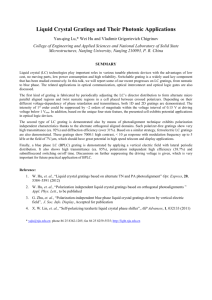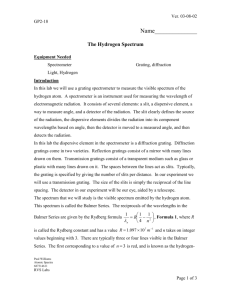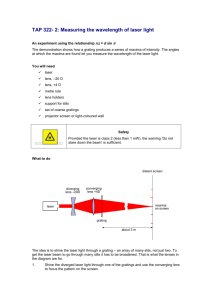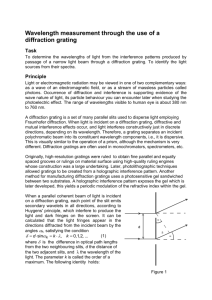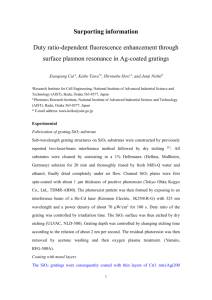Study of Phase Retardation in Subwavelength Metal
advertisement
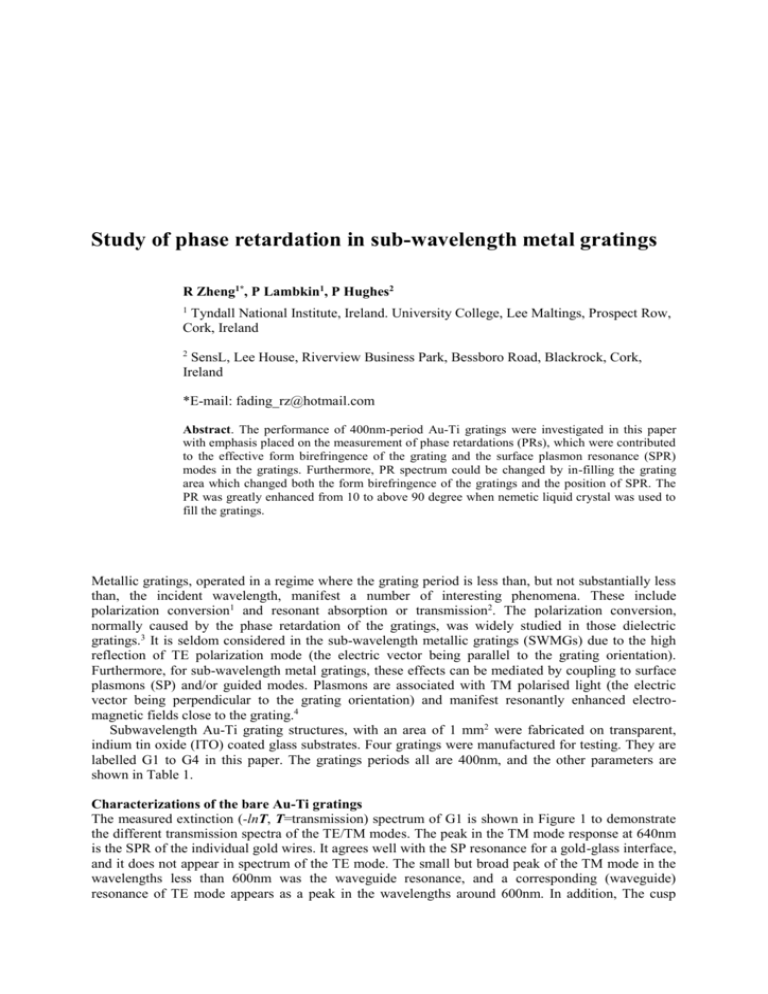
Study of phase retardation in sub-wavelength metal gratings R Zheng1*, P Lambkin1, P Hughes2 1 Tyndall National Institute, Ireland. University College, Lee Maltings, Prospect Row, Cork, Ireland 2 SensL, Lee House, Riverview Business Park, Bessboro Road, Blackrock, Cork, Ireland *E-mail: fading_rz@hotmail.com Abstract. The performance of 400nm-period Au-Ti gratings were investigated in this paper with emphasis placed on the measurement of phase retardations (PRs), which were contributed to the effective form birefringence of the grating and the surface plasmon resonance (SPR) modes in the gratings. Furthermore, PR spectrum could be changed by in-filling the grating area which changed both the form birefringence of the gratings and the position of SPR. The PR was greatly enhanced from 10 to above 90 degree when nemetic liquid crystal was used to fill the gratings. Metallic gratings, operated in a regime where the grating period is less than, but not substantially less than, the incident wavelength, manifest a number of interesting phenomena. These include polarization conversion1 and resonant absorption or transmission2. The polarization conversion, normally caused by the phase retardation of the gratings, was widely studied in those dielectric gratings.3 It is seldom considered in the sub-wavelength metallic gratings (SWMGs) due to the high reflection of TE polarization mode (the electric vector being parallel to the grating orientation). Furthermore, for sub-wavelength metal gratings, these effects can be mediated by coupling to surface plasmons (SP) and/or guided modes. Plasmons are associated with TM polarised light (the electric vector being perpendicular to the grating orientation) and manifest resonantly enhanced electromagnetic fields close to the grating.4 Subwavelength Au-Ti grating structures, with an area of 1 mm2 were fabricated on transparent, indium tin oxide (ITO) coated glass substrates. Four gratings were manufactured for testing. They are labelled G1 to G4 in this paper. The gratings periods all are 400nm, and the other parameters are shown in Table 1. Characterizations of the bare Au-Ti gratings The measured extinction (-lnT, T=transmission) spectrum of G1 is shown in Figure 1 to demonstrate the different transmission spectra of the TE/TM modes. The peak in the TM mode response at 640nm is the SPR of the individual gold wires. It agrees well with the SP resonance for a gold-glass interface, and it does not appear in spectrum of the TE mode. The small but broad peak of the TM mode in the wavelengths less than 600nm was the waveguide resonance, and a corresponding (waveguide) resonance of TE mode appears as a peak in the wavelengths around 600nm. In addition, The cusp around 600nm in TM mode Extinction spectrum is due to the “Rayleigh anomaly”, and it shifted to the long wavelength a little in TE mode at the same wavelength. Table 1 ITO thickness Label grating width (nm) grating thickness (nm) (nm) G1 120 40 120 G2 80 40 120 G3 120 80 50 G4 120 100 50 The transmission spectrums of the TM mode of G1 to G4 are shown in Figure 2. It can be clearly seen that the position and quality of the SPR are greatly affected by the parameters of the gratings, and the deepest SPR appears in G1. The cusp-like Rayleigh anomaly of G1 and G2 looks sharper than that of G3 and G4, which is due to the thicker ITO layer under G1 and G2. 2 TM TE Extinction SPR TM guided mode 1 TE guided mode Rayleigh anomaly 0 550 600 650 700 750 800 850 900 w avelength (nm) Figure 1 Extinction spectrum of the Au-Ti grating (black line for TM mode, dashed line for TE mode) The phase retardations of the grating structures ( TM TE ) were measured based on a Jones matrix analysis and shown in Figure 3. It well indicates that the phase retardation of the grating is greatly affected by the different parameters of the grating and the wavelength of the incident light. The experimental result shows that the positive PR increases towards longer wavelength. This is due to the permittivity of the metal increasing with wavelength, which can be verified by the Drude model. It also indicated that the effective index of TM mode was larger than that of TE mode in the region of these long wavelengths (nTM>nTE). 2 G1 G2 Extinctionon G3 G4 1 0 550 600 650 700 750 800 850 wavelength (nm) Figure 2 Extinction spectrum (TM mode only) of the Gratings (G1-G4) 900 In addition, at the long wavelengths, far away from the SPR, the PR of the grating is proportional to the fill factor and the thickness of the grating. That is consistent with the classic optics theory. Finally, for wavelengths near the SPR, the depth of the PR anomaly is proportional to the quality of the SPR. In other words, the resonance in the PR spectrum of G1 is deepest due to the best quality of SPR in G1 (see Figure 2). Furthermore, the value of PR for some wavelengths in the resonance became negative 80 70 60 50 PR(degree) 40 30 20 10 0 550 -10 600 650 700 750 800 850 900 -20 wavelength (nm) G1 G2 G3 G4 Figure 3 The phase retardations of the gratings (G1-G4) ( 0 ), which indicated that the effective index of TE mode was larger than that of TM mode in the region of these wavelengths (nTM<nTE). In conclusion, the phase retardations of the gratings are due to two contributions, the form birefringence of the binary metallic gratings and the resonant surface modes. However, both of these two contributions are not strong enough to generate great phase retardation in ultra-thin gratings. To solve this problem, it was considered that to fill some nonlinear materials into the gratings. Characterizations of the Au-Ti gratings filled with nemetic liquid crystals It is well known that the electromagnetic field near to metal surfaces can be substantially increased by SPR. Consequently, nonlinear optical effects, associated with an SPR, can be observed when a periodically nano-structured metal film is embedded in a nonlinear optical material. 5 The nonlinear optical material we chose in this work is nematic liquid crystals (NLCs). Therefore the strong electric fields might be used to resonantly orientate the NLC deposited on the grating and, thereby, enhance the form birefringence of the whole sample. In this work we used a NLC named E63 which was purchased from Merck. E63 is a kind of nematic liquid crystal mixture with large birefringence (ne=1.7444, no=1.5172@589nm, clearing point=82 0C). A minimal quantity of NLC was filled into the grating area. Some of them was remaining above the gratings and the thickness of the remaining NLC layer was measured to be about 120nm. For simplification, only the properties of G1 filled with E63 was discussed there. 2 Extinction TM TE 1 0 550 600 650 700 750 800 850 900 wavelength (nm) Figure 4 The extinction of the transmission spectra of G1 when filled with NLC (back for TM mode, grey for TE mode) The extinction spectra of the grating filled with NLC were measured and are shown in Figure 4. The SPR, present only in the TM spectrum, has been red shifted since the gold-air interface is now a gold-NLC interface. Additional structure at short wavelengths is now also present in both polarisations. This is suspected to be attributed to enhanced coupling to substrate and waveguide modes mediated by the grating. PR (degree) The phase retardation of G1 filled with NLC is also 50 shown in Figure 5 and shows a substantially different Bare grating behavior. Large phase 0 retardation (more than 90 550 600 650 700 750 800 850 900 degree) was observed in the NLC film -50 ultra-thin (40nm) metal Filled with NLC gratings filled with E63, which was much larger than -100 the phase retardation in the bare metal grating plus the retardation in the bare LC -150 film. It is noticed that the PR wavelength (nm) of the sample was totally negative after filled with Figure 5 The phase retardation of G1 when filled with NLC, NLC. It indicates that the comparing with that of the NLC film and the bare grating effective index of TE mode was larger than that of TM mode for all of these wavelengths (nTM<nTE). It could only happen when the rod-like LC molecules were well aligned and parallel to the orientation of the grating. It is also named “strong surface anchoring” in the sub-wavelength grating structure.6 This result is contrast to the original hypothesis that the NLC might be directed by the E-field generated by the SPR. The inability of the E-field of the SPs to reorientate NLCs is suspected to be due to the relatively large gap between the grating wires in G1. In addition, although a small resonance did appear at the same wavelength as the SPR position, the influence of SPR is merely perturbative on the much stronger background in the PR spectrum. Discussion and Further work In conclusion, a series of 400nm-period Au-Ti gratings with different parameters were fabricated, the performances of the gratings are investigated in detail, including the SPRs in the transmission spectra of the gratings and the phase retardation in these gratings. Two factors are found to be attributed to the phase retardation of the gratings, namely, the form birefringence of the gratings and the position of the SP modes; the latter only affects the wavelengths near the SPR. The polarization conversion of the sub-wavelength gratings due to form birefringence increases in proportion to the grating thickness. However, the influence of the SPR depends on the quality factor of the resonance. Since the phase retardation in the gratings is not enough to generate great phase, to overcome this shortage, it was considered that to fill NLC into the gratings. The origin of the large effective birefringence observed in the NLC filled grating is obtained. The morphology of the grating is similar to that produced by the rubbing or photo-induced processes on polymer substrates normally used to align liquid crystal molecules.6 However, even with perfect alignment induced by the grating structure, the film thickness is not sufficient to account for the magnitude of the measured retardation. The only possibility is that the birefringence of the NLC was enhanced by the surface modes of the grating structures. Future work will consider simulating the performance of the NLC in an effort to establish the origin of this extraordinary effect. References [1] S.J.Elston, GP Bryan-Brown and JR Sambles Phys.Rev.B 44 6393 (1991) [2] J.A.Porto, F.J.Garcia-Vidal and J.B.Pendry Phys. Rev. Lett 83 2845 (1999) [3] N.Bokor, R.Shechter, N.Davidson, Asher A.Friesem and E.Hasman Applied Optics 40 2076 (2001) [4] [5] [6] H.Raether Surface Plasmon on Smooth and Rough Surface and on Gratings (Springer-Verlag, Berlin, 1988) I.I.Smolyaninov,A.V.Zayats,A.Stanishevsky and C.C.Davis Phys. Rev. B 66 205414 (2002) P.G. de Gennes The physics of liquid crystals (Oxford: Clarendon, 1974)
